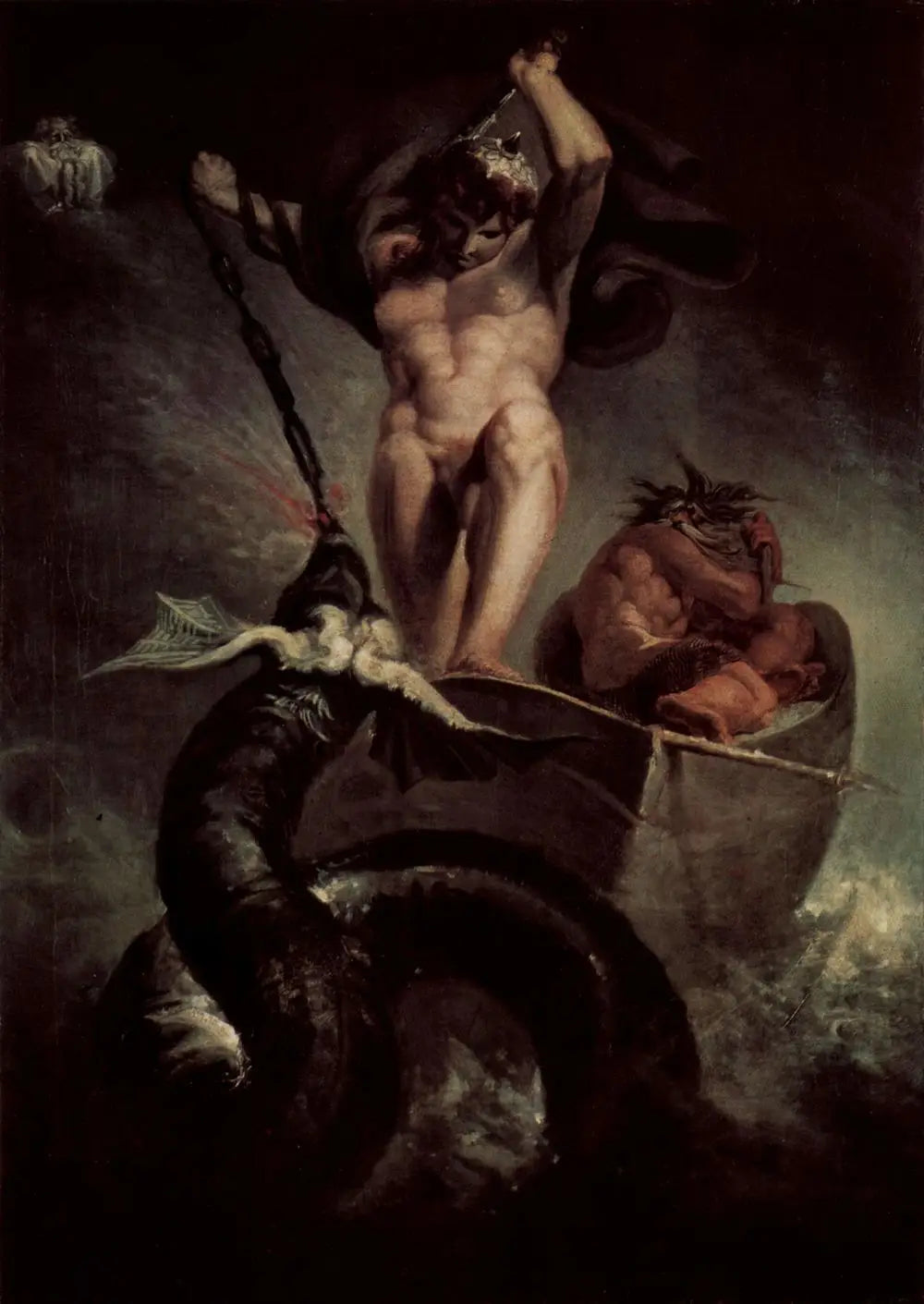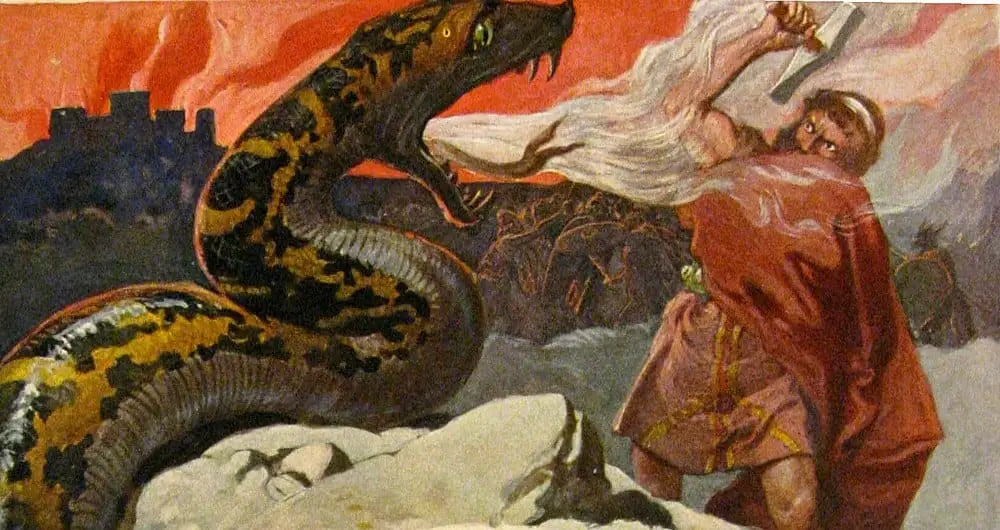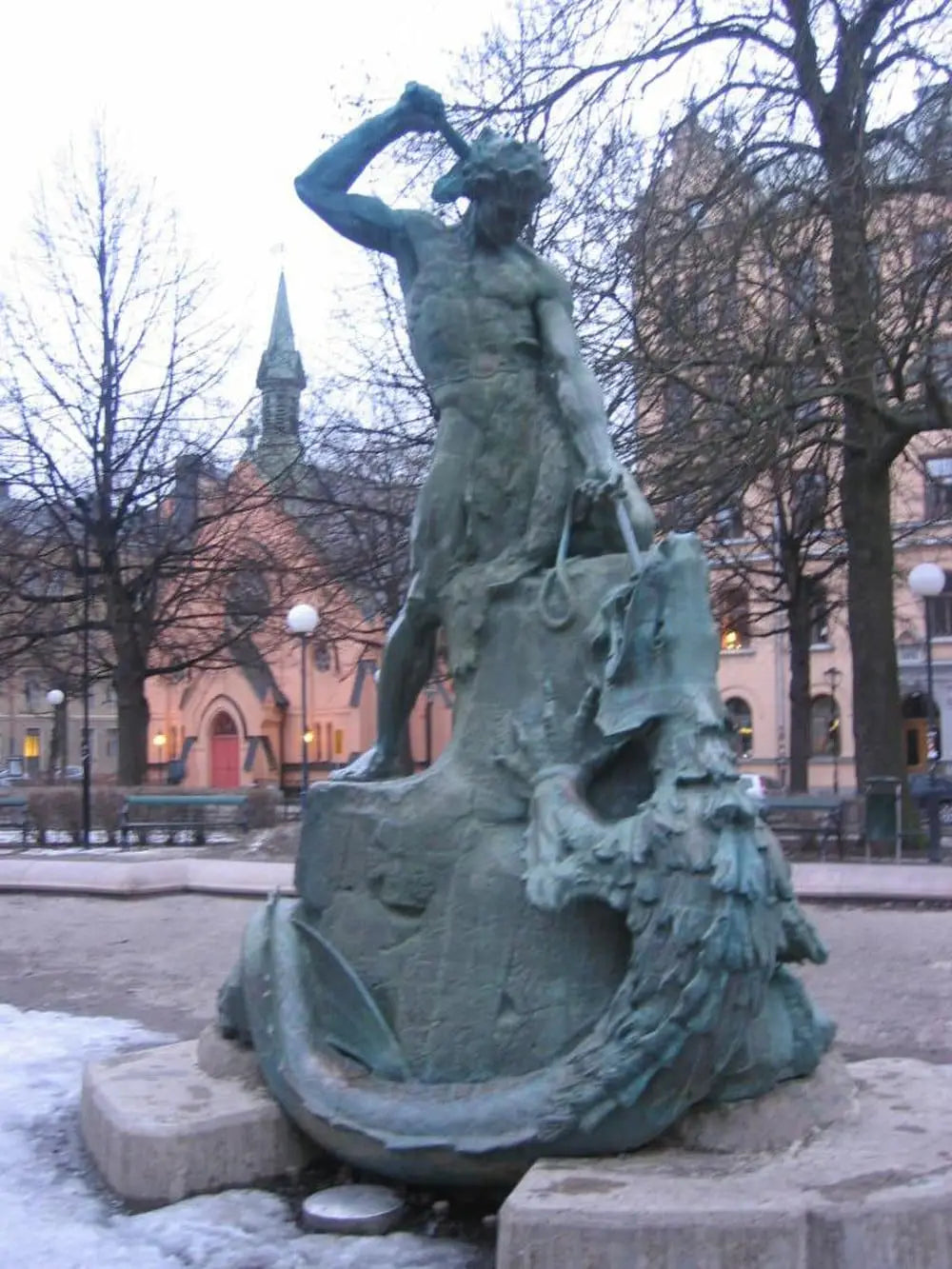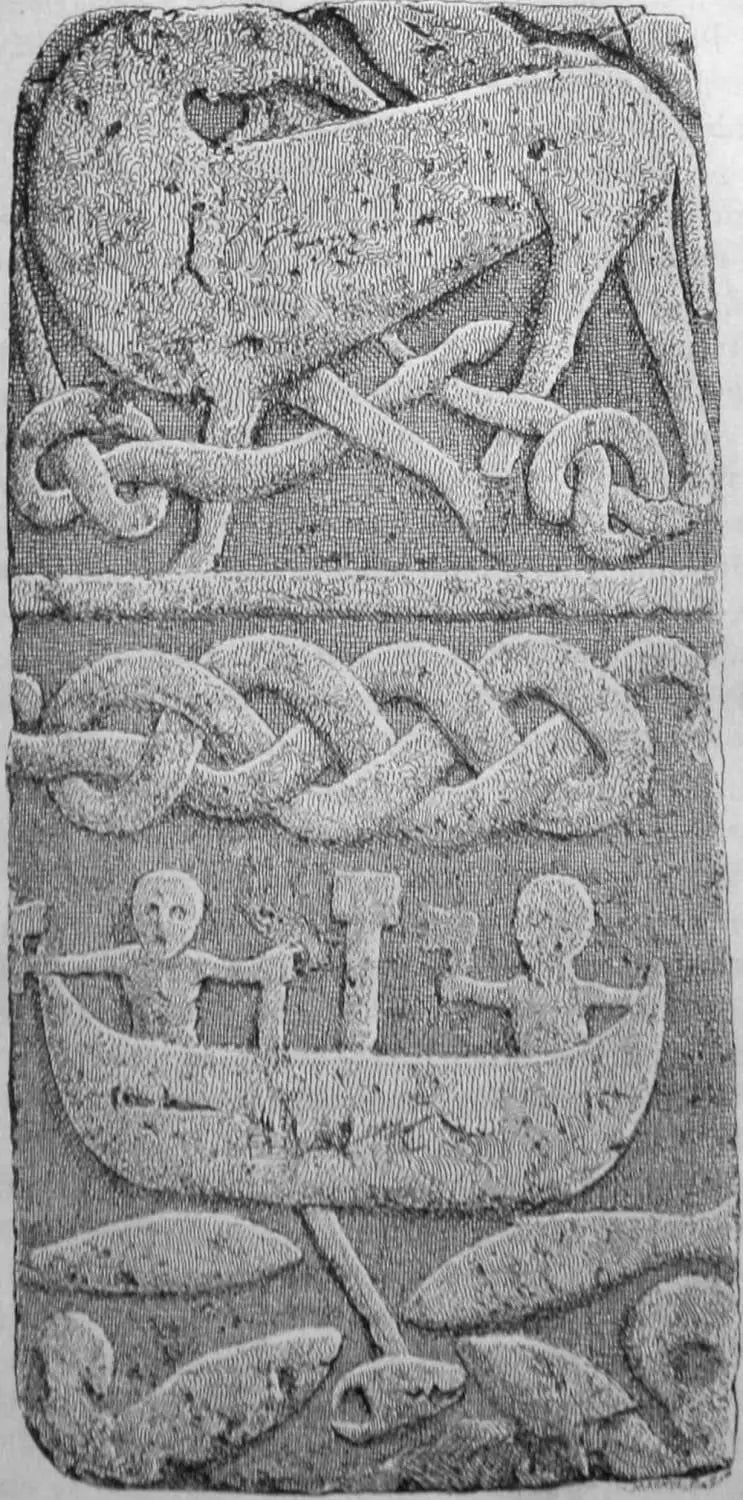Your Cart is Empty
Menu
-
- Shop by Type
- End of Line Sale Items
- New In
- Viking Gifts Under $30
- Hand Forged Axes
- Silver Viking Jewelry
- Stainless Steel Jewelry
- Cremation Jewelry
- Necklaces and Pendants
- Hand Carved Wooden Pendants
- Kings Chains
- Viking Drinking Horns
- Pendant Chains
- Rings
- Bracelets
- Earrings
- Beard Beads and Beard Rings
- Collectables
- Ceramic Mugs
- Street Wear
- Horn Jewelry
- Bronze and Pewter Jewelry
- Shop by Theme
- Viking Axe
- Celtic Jewelry
- Dragon or Serpent
- Viking Raven
- Wolf / Fenrir
- Rune Jewelry
- Odin Jewelry
- Ram / Goat
- Shieldmaidens / Lagertha
- Sword, Spear or Arrow
- Thor's Hammer / Mjolnir
- Tree of Life / Yggdrasil
- Helm of Awe / Aegishjalmur
- Triquetra or Triskelion
- Valknut / Knot of Slain
- Vegvisir / Viking Compass
- Veles / Bear
- Blogs
- Help
-
- Login

Jormungandr

In Norse mythology, Jormungandr also known as the Midgard Serpent is a member of the race of the giants. He is the child of Loki and Angerboda. His siblings are Hel the Underworld Goddess and the giant wolf Fenrir.
Jormungandr lies in the sea of Midgard after Odin, in the Aesir's attempt to control the beast, threw him there to drown him, however the serpent survived and grew so large that it wraps itself around all of Midgard and bites its own tail.
Thor is confronted with Jormungandr twice. The first time, when Thor, Loki and Tjalve visit Utgard-Loki's castle. Here Thor tries in vain to lift a giant cat, which turns out to be Jormungandr in disguide. The second time is during a sailing trip, where Thor is joined by the giant Hymer. Thor lures Jormungandr out and attempts to strike him with Mjolnir, but is interrupted by Hymer that cuts the fishing line..
A seeress has prophesied that Thor and Jormungandr will meet once more, at Ragnarok, where they will fight the final battle. The Midgard Serpent will then come up onto land and wriggle through the valleys and meadows, and during the final battle Thor will kill the serpent, after which he will also fall dead by the serpent's venom.

Characteristics
Jormungandr is described as a gigantic and monstruous sea serpent or dragon, capable of spitting deadly venom, and with a terrifying look if we refer to the myth of Thor's fishing adventure. Its size is such that it surrounds the Earth and bites its own tail.
In the prophetic battle of Ragnarök, it is said that when it emerges from the sea it will cause tidal waves. The scaldic poem Húsdrápa names Jormungandr by the kennings men storðar "necklace of the world", and stirðþinull storðar "rigid rope of the world".
The scaldic poem Ragnarsdrápa names Jormungandr by the kennings endiseiðr allra landa "border-fish of all lands", þvengr "strap" or hringr "ring" of the ocean, hrøkkviáll drekku Völsunga "writhing eel of the Völsungs' drink" (the Völsungs' drink is poison, referring to the myth of the hero Sinfjötli), and vrangr œgir vágs "writhing wave stirrer".
The scald Eysteinn Valdason refers to Jormungandr as kenning seiðr jarðar 'fish of the earth', and Gamli gnævadarskáld as grundar fiskr 'fish of the ground' (these are kennings for snakes, but take on a whole new dimension when referring to Jormungandr, the world-serpent).
According to Snorri's Edda, he is the son of the trickster god Loki and the giantess Angerboda, as well as the brother of the wolf Fenrir and Hel, the goddess of the world and the dead. His kinship with Loki is also attested in the Eddic poem Hymiskvida and the Scaldic poem Þórsdrápa, where the kenning faðir lögseims, "father of the serpent", refers to Loki.
During his early years, Jormungandr is raised in the world of the giants, Jötunheim, but is thrown into the sea by the god Odin because prophecies foretell that he will bring their fall.
The stories about Jormungandr come mainly from the Eddas. The Edda of Snorri, composed in the thirteenth century, tells in prose and in great detail all the known myths about Jormungandr, and also preserves various scaldic poems, one of which dates from the ninth century and describes the same myth.
Otherwise, the Hymiskviða and the Völuspá, from the poetic Edda written in the thirteenth century but composed of older poems, also evoke myths related to Jormungandr. Of the four known myths, three are centered on the encounters between Thor and this sea serpent who end up killing each other.

Jormungandr in the Eddas
Chapter 46 of the Gylfaginning, in Snorri's Edda, tells that Thor and his companions are lodged in the castle of the giant-king Utgard-Loki, who in order to humiliate them offers them seemingly easy challenges but which they inexplicably fail to pass.
Among these challenges, Thor must lift a cat. The god puts all his strength into it but despite his efforts, he only succeeds in getting one of the cat's paws off the ground. We learn in chapter 47 that the next day, Utgard-Loki reveals that he has given them visual illusions.
In reality, the little animal was the serpent Jormungandr himself, whom the king of the giants had given the appearance of a cat. Rather than a humiliation, it was a feat that impressed all the giants.
The myth of Thor's fishing trip is told in several texts, with some variations. It is first described in the scaldic poems Ragnarsdrápa composed in the ninth century by Bragi Boddason and Húsdrápa composed in 983 by Ulf Uggason.
Moreover, we know only three stanzas from the scald Eysteinn Valdason and one stanza from Gamli gnævadarskáld from the tenth century that describe the fishing party as well, thus attesting the antiquity of the myth.
All these stanzas are preserved in Snorri's Edda, which also summarizes the myth, in prose with more details, and Snorri describes this encounter as a direct revenge of Thor for the episode where he is deceived into believing that Jormungandr is a cat to be lifted. Finally, another detailed account is found in the Eddic poem Hymiskvida.
The Eddic poem Hymiskvida tells of Thor going fishing with the giant Hymir, taking with him the head of an ox from his host to use as bait. Thor demands that the giant take him further out to sea but the latter refuses.
Then the giant catches two whales while it is Jormungandr himself that bites Thor's line. Thor is named by the kenning as the "slayer of the serpent" in stanza 22, in reference to the myth of Ragnarök where he kills Jormungandr. The god manages to pull the huge snake on board and he hits it with his hammer Mjolnir, which makes the monster run away. Disgruntled, Hymir takes the way back and keeps questioning the strength of Thor, who ends up killing him.
In Snorri's Edda, the author tells that Thor, in the form of a boy, goes on a fishing trip with the giant Hymir, and tears off the head of an ox to use it as bait. Then Thor rows far out to sea despite Hymir's protests that he fears the Midgard serpent. Thor then prepares a strong line and hooks the ox head.
The hook gets stuck in Jormungandr's palate, and he struggles so much that Thor's feet go through the floor of the boat. Thor manages to pull the snake out of the water, and it spits its venom.
As Thor is about to strike the snake with his hammer Mjolnir, the terrified giant Hymir cuts the line and lets the snake escape. Thor throws the hammer at him anyway without killing him.
Furious, Thor knocks the giant overboard, then walks back to shore. Snorri Sturluson states that "some" say that Thor beheaded the serpent, perhaps referring to the version in the scaldic poem Húsdrápa (stanzas 3-6).
This poem quickly evokes this fishing party, and seems to describe in stanza 6 that with a punch, Thor decapitates the snake. Snorri disputes this version, saying that Jormungandr is still alive in the ocean. The version Snorri adopts is probably that of the scaldic poem Ragnarsdrápa, which he quotes, since the serpent cannot be killed since it reappears afterwards in Ragnarök. The Ragnarsdrápa describes the fishing party in stanzas 14 to 19.
In addition to the large number of preserved texts that refer to it, the popularity of the myth is also confirmed by the fact that it is depicted on four known engraved stones from the Viking Age.

Archaeological sources
The myth of Thor's fishing party is depicted on four Viking Age stones, attesting to its popularity.
The Altuna rune stone in Sweden, dated around 1050, is the clearest. It depicts Thor holding his hammer Mjölnir in one hand and a fishing line in the other, at the end of which is depicted a sea serpent, with Thor's feet crossing the floor of the boat. The other stones represent two people fishing an unidentified animal, but it can be deduced that it is indeed the same myth.
The Gosforth cross in England, dated to the tenth century, allows us to assume that it is indeed the fishing of Jörmungand since an ox head is represented at the end of the line.

The Ardre VIII stone (Gotland, vii century) as well as the Hœrdum stone (Denmark, between vii and xie centuries) also seem to represent this battle .
Otherwise, the scaldic poem Húsdrápa dated 983 consists of a poetic description by the scalde of woodcuts representing myths, including Thor's fishing party. However, this described piece of art has not been found.

